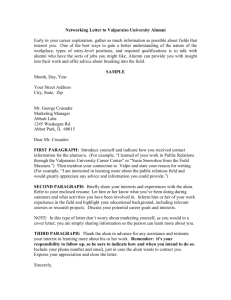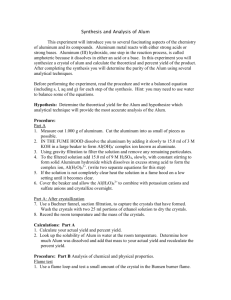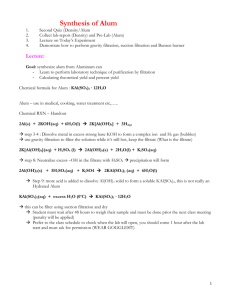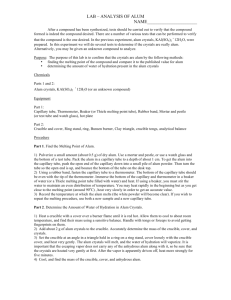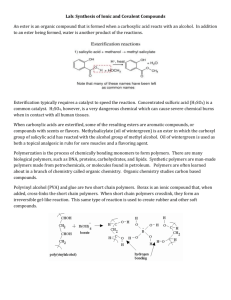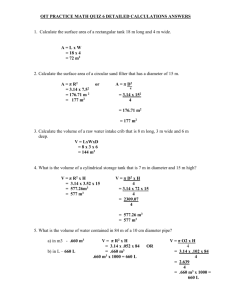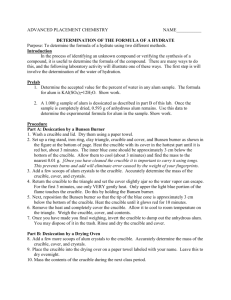Analysis of Alum
advertisement
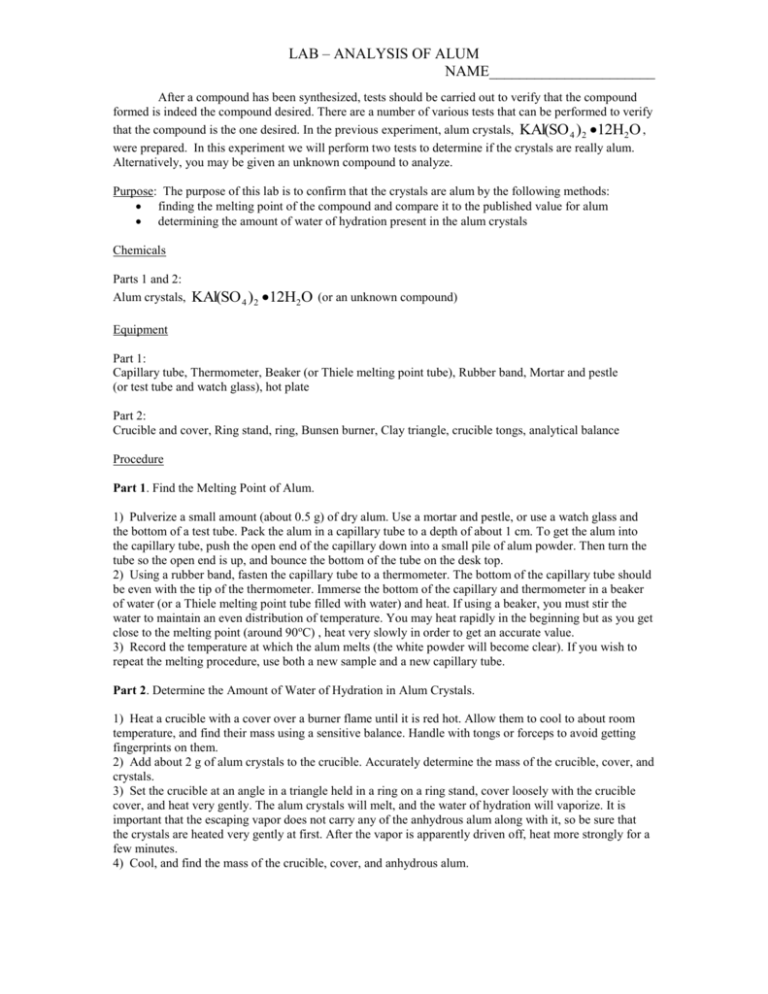
LAB – ANALYSIS OF ALUM NAME______________________ After a compound has been synthesized, tests should be carried out to verify that the compound formed is indeed the compound desired. There are a number of various tests that can be performed to verify that the compound is the one desired. In the previous experiment, alum crystals, KAl(SO 4 ) 2 12H2O , were prepared. In this experiment we will perform two tests to determine if the crystals are really alum. Alternatively, you may be given an unknown compound to analyze. Purpose: The purpose of this lab is to confirm that the crystals are alum by the following methods: finding the melting point of the compound and compare it to the published value for alum determining the amount of water of hydration present in the alum crystals Chemicals Parts 1 and 2: Alum crystals, KAl(SO 4 )2 12H2O (or an unknown compound) Equipment Part 1: Capillary tube, Thermometer, Beaker (or Thiele melting point tube), Rubber band, Mortar and pestle (or test tube and watch glass), hot plate Part 2: Crucible and cover, Ring stand, ring, Bunsen burner, Clay triangle, crucible tongs, analytical balance Procedure Part 1. Find the Melting Point of Alum. 1) Pulverize a small amount (about 0.5 g) of dry alum. Use a mortar and pestle, or use a watch glass and the bottom of a test tube. Pack the alum in a capillary tube to a depth of about 1 cm. To get the alum into the capillary tube, push the open end of the capillary down into a small pile of alum powder. Then turn the tube so the open end is up, and bounce the bottom of the tube on the desk top. 2) Using a rubber band, fasten the capillary tube to a thermometer. The bottom of the capillary tube should be even with the tip of the thermometer. Immerse the bottom of the capillary and thermometer in a beaker of water (or a Thiele melting point tube filled with water) and heat. If using a beaker, you must stir the water to maintain an even distribution of temperature. You may heat rapidly in the beginning but as you get close to the melting point (around 90oC) , heat very slowly in order to get an accurate value. 3) Record the temperature at which the alum melts (the white powder will become clear). If you wish to repeat the melting procedure, use both a new sample and a new capillary tube. Part 2. Determine the Amount of Water of Hydration in Alum Crystals. 1) Heat a crucible with a cover over a burner flame until it is red hot. Allow them to cool to about room temperature, and find their mass using a sensitive balance. Handle with tongs or forceps to avoid getting fingerprints on them. 2) Add about 2 g of alum crystals to the crucible. Accurately determine the mass of the crucible, cover, and crystals. 3) Set the crucible at an angle in a triangle held in a ring on a ring stand, cover loosely with the crucible cover, and heat very gently. The alum crystals will melt, and the water of hydration will vaporize. It is important that the escaping vapor does not carry any of the anhydrous alum along with it, so be sure that the crystals are heated very gently at first. After the vapor is apparently driven off, heat more strongly for a few minutes. 4) Cool, and find the mass of the crucible, cover, and anhydrous alum. LAB – ANALYSIS OF ALUM NAME______________________ Disposal Parts 1 and 2. Your teacher will provide marked containers in which you should place your used capillary tubes and the anhydrous alum. Consult the Flinn Chemical Catalog/Reference Manual, suggested disposal method #26a. See the appendix. Data Part 1: Melting Point of alum _____________ Part 2: Mass of empty crucible and cover ____________ Mass of crucible, cover, and hydrated alum crystals _______________ Mass of crucible, cover and anhydrous alum crystals _______________ Conclusions/Calculations 1. The published melting point of alum crystals is 92.5 oC. Find the percent error of your melting point from Part 1. 2. Why must objects be cooled before their mass is found on a sensitive balance? 3. Calculate the mass of the anhydrous alum and the mass of the water that was driven off. 4. Using your results from #3 determine the number of moles of KAl(SO4)2 and the moles of H2O. Calculate the ratio of moles H2O to moles KAl(SO4)2 and give the calculated formula of alum, KAl(SO 4 ) 2 X H 2 O , where X = the ratio of moles H2O to moles KAl(SO4)2. Compare your value with that of alum. Use the formula in the materials section as reference. 5. Do your tests confirm the substance is alum? Explain using data from both tests. 6. What other tests could be made to verify the composition of alum?

